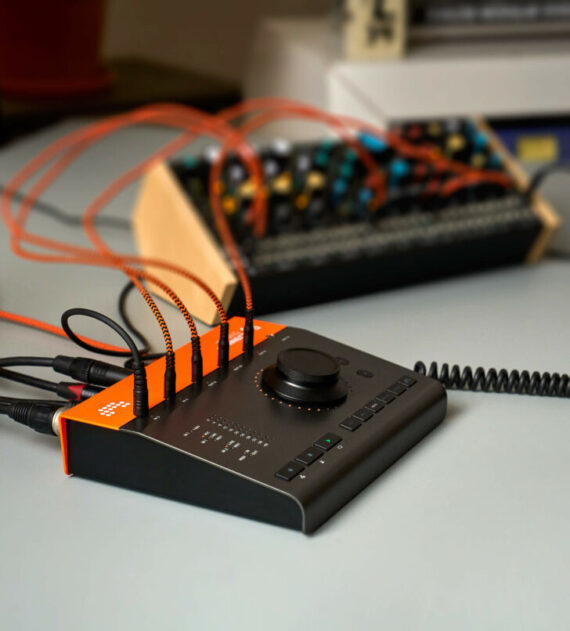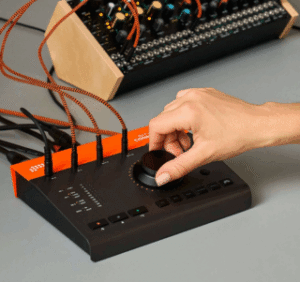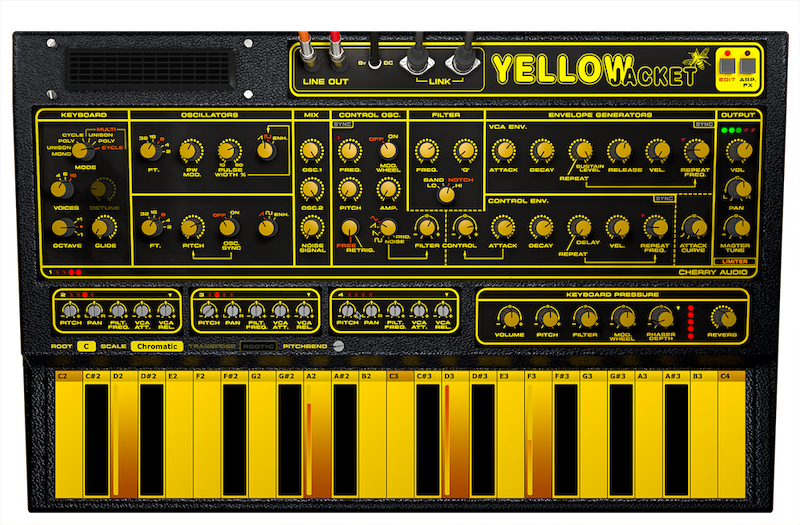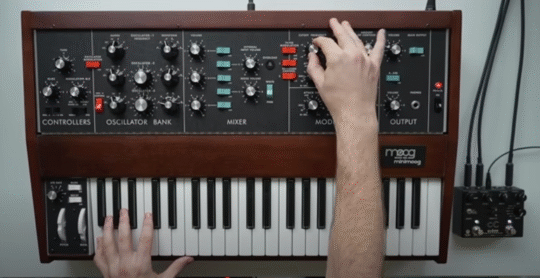Bitwig’s First Hardware Product, Connect 4/12 Now Available

Bitwig‘s first hardware product introduced at NAMM this year is out now: Bitwig Connect 4/12.
More than an audio interface, Bitwig Connect 4/12 is a class-compliant, 4-in/12-out CV and MIDI-enabled audio interface with monitor- and DAW-control functionalities and a unique Bitwig Mode. As a bridge between software and external gear, Bitwig Connect is the perfect device to mark our debut into hardware.
Key Features:
The Ultimate Studio Sidekick.
Bitwig Connect is a three-in-one audio/MIDI interface, monitor and DAW controller. Six mode buttons allow its 360-degree, touch-sensitive dial to adjust interface parameters or control software. It can set input gain, regulate the volume levels for two sets of monitors and a pair of headphones, or even move the playhead and control any Bitwig Studio parameter with exceptional resolution.
The front panel gives the user immediate visual feedback, with accurate input and output meters and a ring of 32 RGB LEDs around the dial to visualize parameter values and automation data. Plus, gain settings are accessible and saved within Bitwig Studio, to pick up right where you left off next time you open it.
Bring Bitwig Studio to Life.
Connect’s unique Bitwig Mode puts Bitwig Studio at your fingertips with DAW controller functionalities. Seamless integration makes writing automation, fine-tuning settings, and navigating the timeline in Bitwig Studio with Connect’s main dial intuitive and precise. Get quick access to any control with the high-resolution dial by hovering over it with your cursor, and lock a selected parameter to Bitwig Connect by double-tapping. The LED ring indicates its current task by matching the color of the parameter or track in Bitwig Studio so you’ll never get lost.
 CV Connects the Best of Both Worlds.
CV Connects the Best of Both Worlds.
With two DC-coupled inputs and four outputs easily accessible via 3.5 mm minijacks directly on the front panel, Bitwig Connect is a superior choice for musicians with CV-enabled hardware. That means it goes both ways: To external devices from Bitwig Studio or other programs, and from hardware sequencers and modulation signals into the software realm.
Thanks to factory calibration, Bitwig Connect plays pitch-perfect and without offset with Bitwig Studio right out of the box. And since jacks can also be used for audio signals, they can act as additional ins and outs for line-level signals, making them useful to all types of users.
Audio Quality at the Top of Its Class.
The hardware inside ensures pristine recordings with every take. Bitwig Connect uses balanced connections, a premium mic preamp, and high-quality instrument/line inputs feeding into tried-and-true AKM converters capable of up to 192kHz, 24-bit resolution. That means the user can capture any source with ultra-low noise floors.
Ready To Go.
Connect’s robust steel chassis is built to endure travel and performance. USB-2 bus powering with the USB-C connector means there’s no external power supply needed, so it can accompany you from the studio to the stage. With hardware this tough, you have a companion for life.
The Story Behind Bitwig Connect 4/12.
The concept behind Bitwig Connect was driven by two key goals: to create an audio interface that seamlessly integrates hardware and software, and to offer a way to physically interact with Bitwig Studio.
 Bitwig Connect bridges the user’s hardware devices, like synths and modular systems, and Bitwig Studio’s comprehensive Hardware Out tools (CV in/out, Analog Clock, MIDI CC, etc.). Its bidirectional CV capabilities extend Bitwig Studio’s unique modulation system and The Grid to your hardware, and vice versa. Bitwig Connect makes this connectivity seemingly effortless with plug-and-play simplicity and visual feedback.
Bitwig Connect bridges the user’s hardware devices, like synths and modular systems, and Bitwig Studio’s comprehensive Hardware Out tools (CV in/out, Analog Clock, MIDI CC, etc.). Its bidirectional CV capabilities extend Bitwig Studio’s unique modulation system and The Grid to your hardware, and vice versa. Bitwig Connect makes this connectivity seemingly effortless with plug-and-play simplicity and visual feedback.
The second idea is embodied in the high-resolution main dial, which offers precise control over everything in Bitwig Studio. Designed to complement your mouse, keyboard, and other MIDI controllers, this intuitive dial delivers a tactile, haptic experience.
Combined Audio Devices in Bitwig Studio 5.3.
Bitwig Studio 5.3 adds major improvements to the program’s audio settings, such as auto-configuration and Combined Audio Devices. The latter option allows macOS and Linux users to integrate Bitwig Connect into their existing audio routing setups by combining multiple interfaces.
Bitwig Connect 4/12 is available starting today for €499/ $599 /£439, via the Bitwig webshop, and from select partners and retailers worldwide. [Please note, the USD price may be adjusted based on changes to international tariffs.] Shipping starts April 28. Check Bitwig’s Buy Local page to find a dealer near you.



